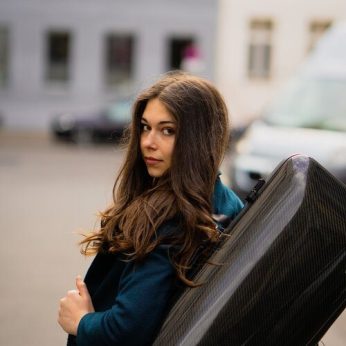Composer: Wolfgang Amadeus Mozart (b. 1756 - d. 1791)
Performance date: 02/07/2023
Venue: Bantry House
Composition Year: 1783
Duration: 00:20:20
Recording Engineer: Tom Norton, RTÉ
Instrumentation: vn, va
Instrumentation Category:Duo
Artists:
Viviane Hagner -
[violin]
Emma Wernig -
[Viola]

Duo for Violin and Viola in B flat K.424 [1783]
1. Adagio – Allegro
2. Andante cantabile
3. Tema con Varazioni – Andante grazioso
In July 1783, Mozart finally summoned up the courage to travel to Salzburg to introduce his wife, Constanze, to his father, who had bitterly disapproved of Mozart’s precipitate marriage to her the previous August. This visit was to be the occasion for the performance of the glorious but uncompleted C minor Mass. In fact it seems that Mozart’s visit was extended by several weeks in the vain hope that he would find the inspiration to complete it. This was not to be, and instead Salzburg got the two Violin/Viola Duos under curious circumstances.
Michael Haydn, the younger brother of Joseph, had been a friend and colleague of the Mozart family for twenty years since his employment by the Salzburg Archbishopric in 1763. When Mozart was only seventeen, he wrote his first string quintet in emulation of two that Michael Haydn had just written. During Mozart’s 1783 visit, the older composer had undertaken to provide a set of six violin/viola duos for the dreaded Archbishop Colloredo, but, owing to his fondness for the bottle, was unable to complete them. Mozart came to the rescue with his pair of duos, composed in Haydn’s style and in the appropriate keys for inclusion in the set, thus enabling Haydn to fulfil his commission and escape the Archbishop’s wrath. One wonders if the prelate noticed the deception, for Mozart was very much persona non grata at his court on account of his defection to Vienna.
The combination of violin and viola is rare notwithstanding the example set by Mozart. Despite their casual and unlikely origin his two Duos bear all the marks of the mature composer with his ability to turn his hand to any combination of instruments; clearly Mozart enjoyed the challenge of helping out his long-time family friend.
The B flat Duo opens with a sombre Adagio introduction to prepare the way for the cheerful Allegro that follows. The totally transparent texture allows audience and musicians to relish the delighted interplay between the instruments. This is followed by a gentle Andante cantabile with the two instruments in reflective mood. The Finale is a set of six variations on an Andante grazioso theme. This divertimento-like movement is deceptively light-hearted considering the level of artistry needed to bring it off.
Francis Humphrys
Copyright © 2025 West Cork Music. All rights reserved.
Designed and developed by Matrix Internet